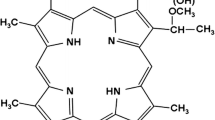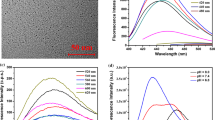Abstract
Background
Photodynamic therapy (PDT) has not been reported for human hepatoma, because cancer cells only weakly take up the photosensitizer. Indocyanine green (ICG) is a photosensitizer normally excreted into the bile, and bile excretion is impaired in human hepatomas. We examined whether human hepatoma cell lines preferentially take up the ICG and then assessed the effectiveness of PDT using ICG and near-infrared (NIR) laser.
Methods
HuH-7 and HepG2 human hepatoma cell lines were transplanted subcutaneously into mice. Developing HuH-7 and HepG2 tumors were confirmed that preferentially took up the ICG in 24 h after ICG was administered to mice via tail vein. The HuH-7 tumor showed a high tumor-to-background fluorescence intensity ratio, 255:1, whereas fluorescence intensity of HuH-7 is increased twofold compared to HepG2. HuH-7 cell transplanted mice were divided into three groups: ICG administration only (ICG+NIR−, n = 8), ICG and NIR laser exposure (ICG+NIR+, n = 12), and NIR laser exposure only (ICG−NIR+, n = 5).
Results
Mean tumor volume in the ICG+NIR− and ICG−NIR+ groups increased steadily. In contrast, mean tumor volume in the ICG+NIR+ group did not change between days 0 and 3. Mean tumor volume did not differ significantly between the ICG−NIR+ and ICG−NIR− groups, but was significantly different between the ICG+NIR+ group and both the ICG−NIR+ and ICG+NIR− groups (p < 0.01).
Conclusions
ICG is preferentially taken up by HuH-7 and HepG2 human hepatoma cell line tumors. The tumor-to-background ratio of HuH-7 tumors, in particular, was extremely high. PDT with NIR laser irradiation suppressed HuH-7 human hepatoma cell line tumor growth.



Similar content being viewed by others
References
Christensen E, Mork C, Skogvoll E. High and sustained efficacy after two sessions of topical 5-aminolevulinic acid photodynamic therapy for basal cell carcinoma: a prospective, clinical and histological 10-year follow-up study. Br J Dermatol. 2012;166(6):1342–8. (Epub 2012/02/09).
Peng Q, Juzeniene A, Chen J, Svaasand LO, Warloe T, Giercksky K-E, et al. Lasers in medicine. Rep Prog Phys. 2008;71(5):056701.
Klein A, Szeimies RM, Baumler W, Zeman F, Schreml S, Hohenleutner U, et al. Indocyanine green-augmented diode laser treatment of port-wine stains: clinical and histological evidence for a new treatment option from a randomized controlled trial. Br J Dermatol. 2012;167(2):333–42. (Epub 2012/03/23).
Urbanska K, Romanowska-Dixon B, Matuszak Z, Oszajca J, Nowak-Sliwinska P, Stochel G. Indocyanine green as a prospective sensitizer for photodynamic therapy of melanomas. Acta Biochimica Polonica. 2002;49(2):387–91. (Epub 2002/10/05).
Hirano T, Kohno E, Gohto Y, Obana A. Singlet oxygen generation by irradiation of indocyanine green and its effect to tissues. J Japan Soc Laser Surg Med. 2007;28:122–8.
Shafirstein G, Bäumler W, Hennings LJ, Siegel ER, Friedman R, Moreno MA, et al. Indocyanine green enhanced near-infrared laser treatment of murine mammary carcinoma. Int J Cancer. 2012;130(5):1208–15.
Ishizawa T, Fukushima N, Shibahara J, Masuda K, Tamura S, Aoki T, et al. Real-time identification of liver cancers by using indocyanine green fluorescent imaging. Cancer. 2009;115(11):2491–504.
Nakabayashi H, Taketa K, Miyano K, Yamane T, Sato J. Growth of human hepatoma cells lines with differentiated functions in chemically defined medium. Cancer Res. 1982;42(9):3858–63. (Epub 1982/09/01).
Aden DP, Fogel A, Plotkin S, Damjanov I, Knowles BB. Controlled synthesis of HBsAg in a differentiated human liver carcinoma-derived cell line. Nature. 1979;282(5739):615–6. (Epub 1979/12/06).
Inagaki Y. Effect of c-Met inhibitor SU11274 on hepatocellular carcinoma cell growth. BioScience Trends. 2011;5(2):52–6.
Diehl KH, Hull R, Morton D, Pfister R, Rabemampianina Y, Smith D, et al. A good practice guide to the administration of substances and removal of blood, including routes and volumes. J Appl Toxicol. 2001;21(1):15–23. (Epub 2001/02/17).
Kwon S, Sevick-Muraca EM. Non-invasive, dynamic imaging of murine intestinal motility. Neurogastroenterol Motility. 2011;23(9):881–e344. (Epub 2011/06/01).
Reindl S, Penzkofer A, Gong SH, Landthaler M, Szeimies RM, Abels C, et al. Quantum yield of triplet formation for indocyanine green. J Photochem Photobiol A. 1997;105(1):65–8.
Brown SB, Brown EA, Walker I. The present and future role of photodynamic therapy in cancer treatment. Lancet Oncol. 2004;5(8):497–508. (Epub 2004/08/04).
Kessel D. Death pathways associated with photodynamic therapy. Med Laser Appl. 2006;21(4):219–24. (Epub 2006/11/15).
Thayer D, Unlu MB, Lin Y, Yan K, Nalcioglu O, Gulsen G. Dual-contrast dynamic MRI-DOT for small animal imaging. Technol Cancer Res Treat. 2010;9(1):61–70. (Epub 2010/01/20).
Kim TH, Mount CW, Dulken BW, Ramos J, Fu CJ, Khant HA, et al. Filamentous, mixed micelles of triblock copolymers enhance tumor localization of indocyanine green in a murine xenograft model. Mol Pharm. 2012;9(1):135–43.
Mitsunaga M, Ogawa M, Kosaka N, Rosenblum LT, Choyke PL, Kobayashi H. Cancer cell–selective in vivo near infrared photoimmunotherapy targeting specific membrane molecules. Nat Med. 2011;17(12):1685–91.
Otake M, Nishiwaki M, Kobayashi Y, Baba S, Kohno E, Kawasaki T, et al. Selective accumulation of ALA-induced PpIX and photodynamic effect in chemically induced hepatocellular carcinoma. Br J Cancer. 2003;89(4):730–6.
Ogawa M, Kosaka N, Choyke PL, Kobayashi H. In vivo molecular imaging of cancer with a quenching near-infrared fluorescent probe using conjugates of monoclonal antibodies and indocyanine green. Cancer Res. 2009;69(4):1268–72.
Fox IJ, Wood EH. Applications of dilution curves recorded from the right side of the heart or venous circulation with the aid of a new indicator dye. Proc Staff Meet Mayo Clinic. 1957;32(19):541–50. (Epub 1957/09/18).
Iijima T, Aoyagi T, Iwao Y, Masuda J, Fuse M, Kobayashi N, et al. Cardiac output and circulating blood volume analysis by pulse dye-densitometry. J Clin Monit. 1997;13(2):81–9. (Epub 1997/03/01).
Cherrick GR, Stein SW, Leevy CM, Davidson CS. Indocyanine green: observations on its physical properties, plasma decay, and hepatic extraction. J Clin Investig. 1960;39:592–600. (Epub 1960/04/01).
Hochheimer BF. Angiography of the retina with indocyanine green. Arch Ophthalmol. 1971;86(5):564–5. (Epub 1971/11/01).
van Gemert MC, Welch AJ. Clinical use of laser-tissue interactions. IEEE Eng Med Biol Mag. 1989;8(4):10–3. (Epub 1989/01/01).
Hock C, Villringer K, Muller-Spahn F, Wenzel R, Heekeren H, Schuh-Hofer S, et al. Decrease in parietal cerebral hemoglobin oxygenation during performance of a verbal fluency task in patients with Alzheimer’s disease monitored by means of near-infrared spectroscopy (NIRS)—correlation with simultaneous rCBF-PET measurements. Brain Res. 1997;755(2):293–303. (Epub 1997/05/02).
Acknowledgments
This work was supported by grants 21791271 (Kaneko) and 23249067 (Kokudo) from the Ministry of Education, Culture, Sports, Science, and Technology of Japan, and 2011 Tokyo Igakukai Medical Research Grants (Kaneko). We thank Dr. Yutaka Takazawa for helpful comments and suggestions regarding the pathology findings; Harukuni Tsuda for excellent technical assistance with the microscopic fluorescence evaluation; Yasuyuki Morishita for excellent technical assistance with histological preparation.
Conflict of interest
The authors declare that they have no conflict of interest.
Author information
Authors and Affiliations
Corresponding author
Electronic supplementary material
Below is the link to the electronic supplementary material.
When the power density of the NIR light was increased from 0 to 4 mW/cm2, the entire mouse body (Immediately after ICG administration) and HuH-7 tumor (24 h after ICG administration) showed increased fluorescence intensity. When the NIR light was turned off, the fluorescence disappeared (MPG 10196 kb)
Rights and permissions
About this article
Cite this article
Kaneko, J., Inagaki, Y., Ishizawa, T. et al. Photodynamic therapy for human hepatoma-cell–line tumors utilizing biliary excretion properties of indocyanine green. J Gastroenterol 49, 110–116 (2014). https://doi.org/10.1007/s00535-013-0775-4
Received:
Accepted:
Published:
Issue Date:
DOI: https://doi.org/10.1007/s00535-013-0775-4




